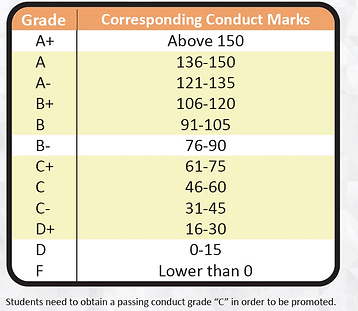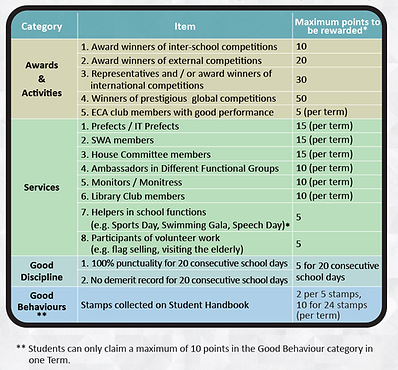

Attendance
School Hours
-
Students should arrive at school at 8:00 a.m. in the morning session or at 1:25 p.m. in the afternoon session.
-
Students may enter the school premises from 7:30 a.m. onward.
-
The lunch break is from 12:25 p.m. to 1:25 p.m. every day. Students are allowed to leave the school premises during lunch time. Students are advised to return to school 5 minutes before the end of lunch time.
-
After 5:30 p.m. students must leave the school premises.
Lateness
Students arriving later than 8:00 a.m. in the morning or after 1:25 p.m. in the afternoon will be
regarded as being late; demerits will be issued to late comers.
For students arriving late
-
An eClass record will be issued each time a student is late. Each day is divided into two sessions: one in the morning and one after lunch. If students are late in the afternoon, an eClass record will also be issued.
-
Latecomers must attend a 30-minute lunch reflection session on the same day in the designated areas.
-
If a student is late for three times, the class teacher will arrange a meeting with the parents. In addition to attending a lunch reflection session, the student must submit a reflection report signed by a parent or guardian during the parent meeting.
Absence
-
Students who are absent from school due to sickness must upload a medical certificate to eClass within one week.
-
Students applying for special leave must apply at least one week in advance. The school will consider leave applications on a case-by-case basis for approval. A long leave application form can be asked from the class teachers.
-
Early leave for an appointment must be approved by the school.
-
A student who has been absent for more than 20 days throughout the Academic Year may not be eligible for promotion. Therefore, long leaves are not advised during school days.
-
If students are absent without proper supporting documents, an eClass record for the absence will be issued.
-
A student who has been absent for more than 20 days over the school year may not be eligible for promotion. Therefore, long leaves are not advised during school days.
-
If a student is absent without proper supporting documents, an eClass record for the absence will be issued.
Appearance
-
Hairstyle should be neat and color should be natural and simple.
-
Hair should be above the eyebrows.
For boys: Hair should be above the collar of the shirt. Hair on the temples should be
above half of the ear. Any hair clips or hair tie are not allowed.
For girls: For those whose hair reaches their shoulders, they must hold the hair together
with plain black hair tie. Only black hair clips/hair tie are allowed.
-
Hairstyling products, like gel, should not be used. Excessive hair coloring (colors considered as non-natural hair color), distracting hairstyles are not allowed.
-
No accessory is allowed (Unless for religious reasons. Students may approach class teachers for further details.)
-
Color of turbans or scarves should be only plain black or white.
-
If earrings need to be worn, only one pair of pellet-shaped plain studs (same style) is allowed as lowest as possible. For the nose or other parts of the ears, students may only use transparent plastic sticks. No others accessories are allowed. (Unless for religious reasons. Students may approach class teachers regarding the procedure of approval.)
-
Long fingernails, nail polish and make-up (including colored lip balm or tint) are not allowed.
Conduct Assessment
Positive Education
At DeliaGP, we believe in the importance of positive education, which includes skills and attitudes
that help every student flourish. The Positive Education Assessment Framework below is used to
support and encourage the students’ personal growth.
Junior Form
Throughout the school year, teachers will observe and support the students’ development in several
key areas. For each item, each student’s progress is described using one of four categories:
-
Excellent: Always demonstrates this skill or attitude independently and proactively.
-
Good: Frequently demonstrates this skill or attitude, sometimes with reminders.
-
Fairly Good: Sometimes demonstrates this skill or attitude, needs some support.
-
Developing: Rarely demonstrates this skill or attitude, needs significant support.
Senior Form
-
Each student has a basic Conduct mark of 100 (Grade B).
-
Conduct marks are accumulated throughout the Academic Year.
-
Conduct marks will be added to or deducted from the basic mark (Grade B) when a demerit or merit is given.
-
The scale of marks and Conduct grades are as follows:

Merit List

Demerit List
